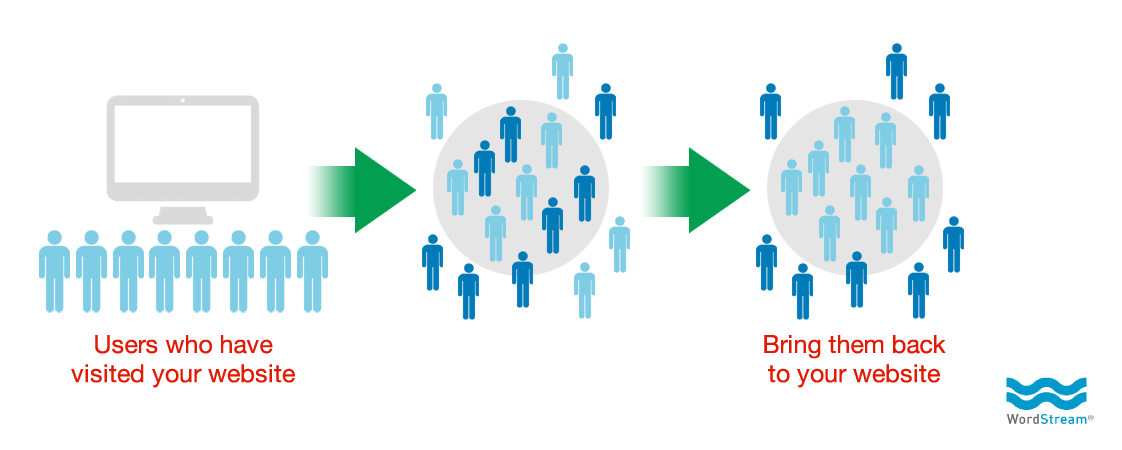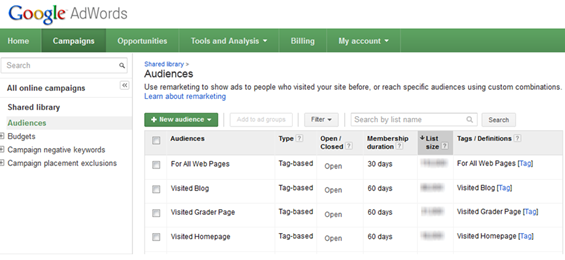Retargeting is a paid search marketing strategy whereby website visitors are identified and remarketed to using search or social media ads. In other words, retargeting is a way to reach specific audiences who’ve already shown interest in your business. As online marketing methods converge and we find new and creative ways to stay connected with our audience, retargeting is something every content marketer should do.
SEO has always been an effective lead generation tool for my company, though we identified a need to better connect with the website visitors we were drawing in. The WordStream blog has about half a million visitors each month and has seen a compound monthly growth rate of 8.4% over the last six years, so we certainly weren’t hurting for traffic! A few years ago, however, we noticed a few problematic issues:
- Low visitor engagement, demonstrated by metrics showing just 1.9 pages per visit, average visit duration of a paltry 1 minute and 34 seconds, and an incredibly high new visitor ratio of 79.2%.
- Very low conversion rate (under 2%).
- Too few branded searches — in fact, only 3% of our site visitors were explicitly looking for our brand.
Our issues were not really all that unique — data from Forrester shows that96% of website visitors just don’t convert to a lead or sale. So how do you recapture the interest of these previous visitors and continue to nurture them?
For us, the answer was retargeting.
The Retargeting Process
Basically, site visitors are tagged, then targeted with banner ads for a specific period of time on other websites. These ads might appear on Facebook, Google’s search results pages, or any website that is part of the advertising network in which you participate.

This is a great chance to get back in front of people who have already expressed an interest in your content, with messaging that reflects this familiarity with your brand. Retargeting can help you to:
- Reconnect with people who bounced from your site or even abandoned a cart.
- Increase brand recognition and recall.
- Encourage repeat site visits and boost engagement.
- Increase the effectiveness of your SEO and content marketing tactics.
We chose the Google Display Network for our retargeting campaigns, simply because of the massive network size.
With over 2 million sites in its network plus AdMob mobile targeting, Google’s network is unrivaled in sheer size and scope. In fact, the average marketer using Google’s Display Network for retargeting is able to connect with 84% of the people tagged, 10-18 times per month.
Getting Started With Retargeting
Inbound marketers inherently understand audiences — which is critical to your success in retargeting. Creating different audiences allows you to adjust your bidding strategy and ads for the different types of people you want to reconnect with.

At WordStream, we first identified a few key segments (as shown above):
- People who visited our blog
- People who visited our homepage
- People who visited one of our free tools
- People who visited anywhere else on our site
It’s safe to assume that on their first visit, these people were looking for different types of information. Why would we now assume they’re all the same and one type of message will draw them all back in?
Audience segmentation also allowed us to bid with various levels of aggression, depending on what we knew about the level of intent of each type of visitor.
For example, a person who used our AdWords Grader tool shows far greater intent as a business lead than a person who read a post on our blog — in the former case, we know for sure they are a) using AdWords and b) looking for help.
Next, you need to decide how long you want to remarket to these people. We initially went with a period of 30-60 days, which some might consider a bit overboard. We tested, though, and that was what worked for our campaign.
Retargeting Tips and Takeaways for Marketers
By now, I hope you understand the “what” and the “why” of retargeting for marketers. Now, how do you go about optimizing a campaign? Well, there’s a handful of ways you can do this:
- Use ad formats that accomplish two important things: Drive a call-to-action and improve brand recall through creative branding and images.
- Keep A/B testing with different ad creative to find the most memorable copy and image combos that drive the greatest CTR (aim for 0.4% or higher).
- Leverage the data you already have at your disposal for more precise targeting (i.e. blog category visitors). You can tell which information category interested a group of visitors, so use that insight to target them with relevant ads.
- Allocate your budget to retargeting. I actually think it’s kind of crazy to spend the kind of money we do on SEO and content marketing without then retargeting! You might not capture their undivided interest the first time, but you maximize the value of each marketing tactic when you are able to bring a visitor back.
- Test, test, test, and measure. Understand which metrics matter to your brand before you set out on your remarketing journey, so you’re able to clearly and accurately gauge campaign performance as you go.
Retargeting has been an incredible tool for us — within 20 months, WordStream saw:
- A 50% increase in repeat site visitors.
- A 300% increase in engagement (as measured by time on site, which is now approaching 5 minutes per visit!).
- A 51% increase in website visitor-to-lead-form-submitted conversions.
So marketers: Are you using remarketing to market the content that you produce? Why or why not? If you have tried it, were the results? Share your thoughts in the comments below!

Recent Comments